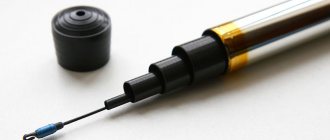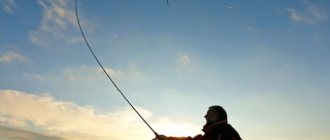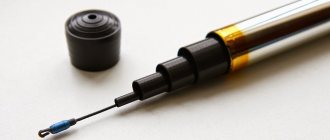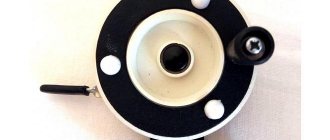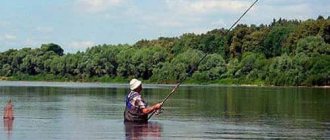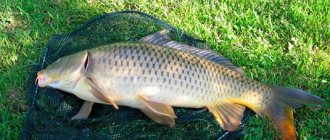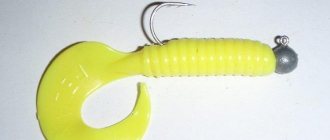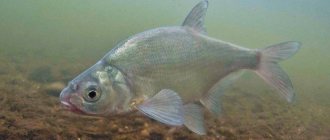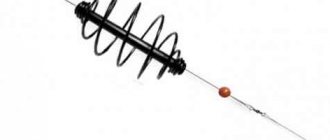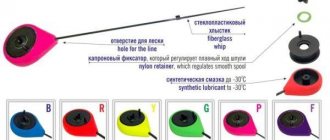General description of the fly rod
In its classic form, a fly rod is a long whip made from a flexible tree branch, a strong stalk of reeds. It can also be a composite bamboo stick. There are no unnecessary elements: a fishing line with a float, a sinker and a hook is attached to the tip. The length of the line is equal to the size of the rod. The fisherman sends the bait into the pond with a wave from himself.
With the development of the fishing industry, the wooden whip was transformed into fishing rods made of modern durable and lightweight materials. The handles were made with notches for ease of grip, reels and rings appeared on the forms, and a reel was included in the package. But these are minor elements that you can do without. With all the current design and equipment, it is impossible to confuse a float fly rod with other fishing gear - just as it is impossible to abandon it.
In some situations of a fishing session, an ancient tool is almost the only possible way to get prey. Therefore, the equipment of a fly rod, the installation of equipment, and the technique of fishing on the “swing” remain relevant.
Material
Natural materials – wood and bamboo – remain in high esteem among fishing connoisseurs. Many people make their own fishing rods, drying flexible walnut rods for several months using a special technology.
Types of rods
But it’s still easier to buy finished products made from polymers:
- Fiberglass. Cheap material is difficult to use in a fly rod due to its heavy weight. But just such a tool is recommended for a beginner, because a very durable stick is not afraid of mechanical damage. It is difficult to use and transport, so take a fiberglass rod no longer than 4 meters.
- Carbon (carbon fiber, graphite). Carbon fiber products are expensive, but light and flexible. They have good action, length up to 12 m. The lightest thin-walled fishing rods are made from high-modulus graphite, so they are fragile. Fishing devices made from ordinary carbon fiber are stronger, but heavier: in any case, their mass is less than fiberglass. Treat carbon fiber fishing rods with care during transportation and casting, especially in windy weather, and do not allow dirt to get into the joints between sections. The strength and lightness of carbon fiber are encoded in the markings: from IM-4 to IM-9. The higher the number, the better the stated characteristics.
- Composite An alloy of carbon and fiberglass produced a material that was average in price and technical specifications. The rods are lighter than fiberglass options and cheaper than carbon products. Composite daughters are resistant to loads and mechanical influences: the path to big fishing begins with them.
The material affects the weight of the swing. The smaller the weight of the fishing tool, the easier it is to control, and the lower the degree of fatigue of the fisherman.
Length
The size of the fly rod is an important indicator, which varies between 1.5-12 m. The choice of length is determined by the intended casting distance, so take 2-3 fishing rods of different sizes for fishing.
By length, rods are conventionally divided into groups:
- 1.5-4 m. For catching small bottom-dwelling specimens from a boat or speedboat. The casts are short - exactly to the bait spot that you have created in the middle of the reservoir, the fishing pace is active.
- 5-7 m. Universal, the most common category. The size of the expected prey is 3 kg, the water is stagnant or weakly flowing, the distance is average.
- 7-9 m. For fishermen with proven long-range practice. Good for delivering bait to a precisely specified location and landing a trophy. A Bolognese fishing rod will work ideally here, but with certain skills you can successfully cope with the fly version.
- 9-11 m. Such fishing rods are used by athletes and professionals in specific conditions.
The relationship between the length of the fly rod and the casting distance is summarized in the table:
| Form length, m | Casting distance, m |
| 6 | 9 |
| 7 | 11 |
| 8 | 13 |
| 9 | 14 |
The “mach” forms can be composite. Pay attention to the number of elbows and joints: the fewer there are, the easier the fishing device.
Test
The digital values of the form test are printed on the handle or second leg of all purchased fishing rods. The parameter serves as a guideline for the minimum and maximum weight of the bait that can be used on this equipment.
The first two numbers indicate the smallest weight in grams (this includes the feeder and float weight) that can be cast with this fishing rod. According to an unspoken rule adopted among manufacturers of fishing products, these digital values correspond to the length of the form, only in meters. You can violate the lower limit, but you will not get the required casting distance, and the fishing will be ineffective.
The second digits of the marking indicate the upper limit of the weight allowed for casting. Violation of the value threatens to break the form. This is important to understand for those who are interested in the correct selection of a fly rod and installation of equipment.
Example. Marking on the form: “10-50”.
Explanation:
- rod length – 10 m;
- the minimum permitted weight of cargo is 10 g (you can violate it);
- The upper limit for the weight of complementary foods together with the weight of the float is 50 g (you cannot go abroad).
Homemade “swings” are also divided according to the test, but only an experienced fisherman can determine the indicator by estimating the length and weight of the rod. If you are confused by this question, ask your friends to determine the test of your fishing rod.
Build
Under load, the rod body bends. In what part and by what amount - the system will tell about this. Without taking it into account, proper equipment and installation of a fly rod is impossible.
According to this parameter, fishing rods are divided into three groups:
- Fast (F) – fast formation. From the applied force of the load, only the top of the fishing rod bends. With such a tool it is easy to learn how to cast long distances, because the rest of the body of the blank does not bend. By lifting the stick, you will also drag the feeder over an edge or rock.
- Medium (M) – medium tuning. At the moment of casting or hooking, the stick bends in the middle. This “average” device is a suitable device for beginners.
- Slow (S) – slow tuning. Under load, the entire body of the fishing rod bends down to the handle. It is more difficult to control fishing; it is impossible to pull the food container out of the hole. But slow action equipment has its uses in certain situations. For example, in reservoirs with a smooth bottom and without snags, the fish have no chance of getting off the hook.
In addition to the main classification by tuning, there are intermediate options: super-fast, medium-fast and others. The letter parameters for the bend of the form are located next to the test designation.
Your question to an expert
Leonid Grachev
Fisherman with a lot of knowledge and experience
Ask a Question
Types of fishing rods for summer fishing
For each method of open water fishing, there are certain types of fishing rods for summer fishing. They differ in their design and basic performance characteristics, depending on the use of bait and the method of supplying the bait to the fishing area. Let's move on to considering the types of fishing rods based on their classification, which will give the fisherman the opportunity to even visually differentiate gear for fishing in different areas of hunting.
Float rods
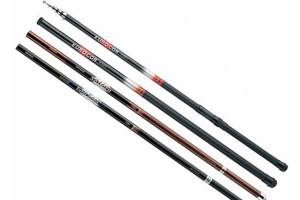
This type of tackle includes fly fishing rods, Bolognese fishing rods, match fishing rods and plug fishing rods. The listed types of rods allow you to successfully fish with float rigs at various distances and with varying degrees of accuracy in delivering bait to a promising fishing point. Bolognese tackle is universal in this regard. This type of fishing tool has built-in guide rings along the entire length of the blank and is equipped with a spinning reel, which facilitates accurate and long-distance casting and fishing for fish of various sizes.
Plug tackle is distinguished by its particular precision in delivering bait to a specific place. Also, due to the design features, and in particular the supply of the quiver tip with feedergam, the fishing rod makes it possible to fish with particularly thin rigs and hunt for cautious and not very active fish at distances from 9 to 20 meters from the coastline.
Fly rod
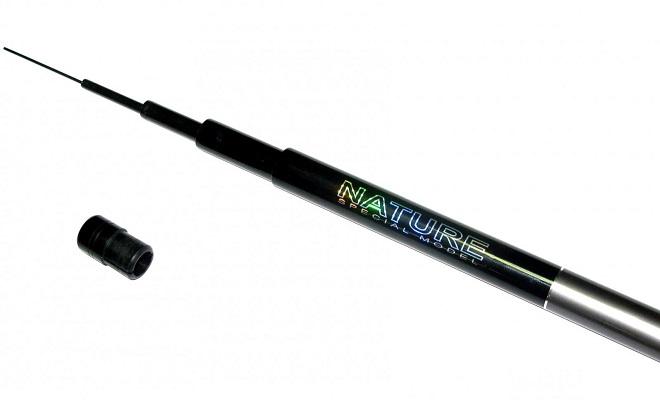
This type of fishing rod is classified as the most common and simplest type of float tackle in structure. You can safely call a fly rod a fishing rod for beginners. After all, it is with the classic swing that a large number of anglers begin their acquaintance with fishing. The operating principle of the tool is based on feeding the bait into the fishing zone by swinging the form, to which a float rig is attached to the blind. The fishing rod allows you to catch fish of different sizes near the shore or boat at a distance of up to 8–10 meters.
Feeder
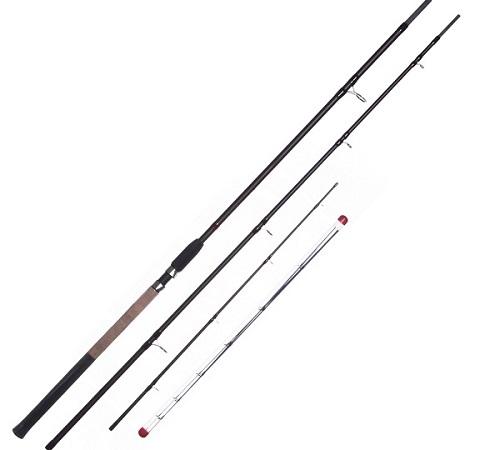
These types of fishing rods are designed for bottom fishing using feeding troughs. The characteristics of the gear allow long-distance casting and landing of large fish, over 100 meters with certain equipment. Special types of rigs have been developed for the type of fishing, the contact of the fish with the bait is transferred to a particularly sensitive quivertype of the tackle form.
Match
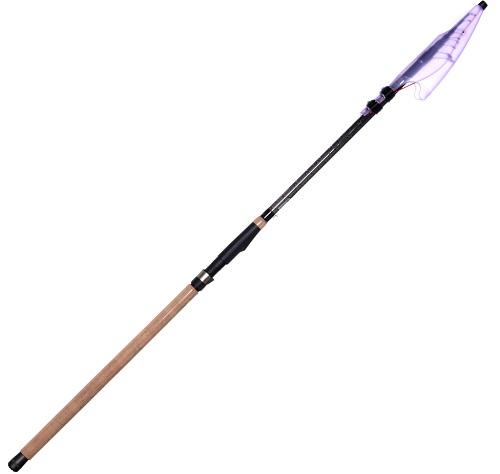
Match gear differs from other designs in the ability to supply bait by long-distance casting of a float. When producing this type of tackle, the manufacturer scrupulously balances the capabilities of the blank material and its length to achieve long-distance casting without particularly heavy installation. The method of this type of float hunting helps to catch cautious fish at long distances from the shore, regardless of its mass.
Important! A match type tool is used on lakes and wide rivers in both standing and flowing waters.
Fly fishing rod
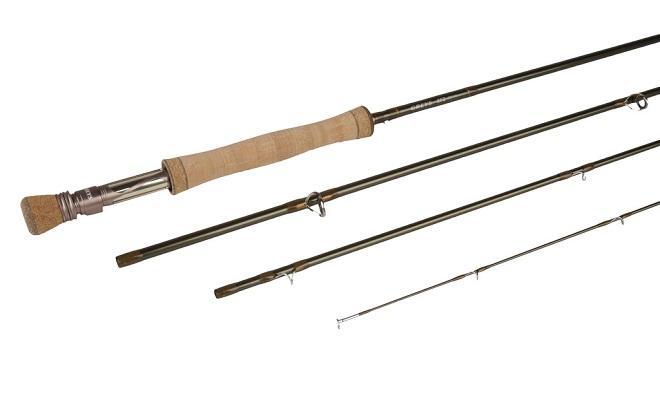
A specific and thin type of gear that the manufacturer makes for catching surface fish with light baits of artificial and natural origin, supplied to the fishing zone on special cords, the discharge and reeling of which is carried out by means of an inertial reel. The choice of a rod based on its length and the reliability of the form is carried out based on the trophy planned for catches.
The technique of working with this specific tool requires a stable skill, which is achieved by anglers as a result of fly fishing practice. When choosing a fishing rod for beginners, special attention will be paid to weight, since dynamic fly fishing, coupled with training, greatly tires the fisherman’s hands, and a heavy blank does not contribute to quickly mastering the technique of delivering a light bait to a certain area.
Spinning
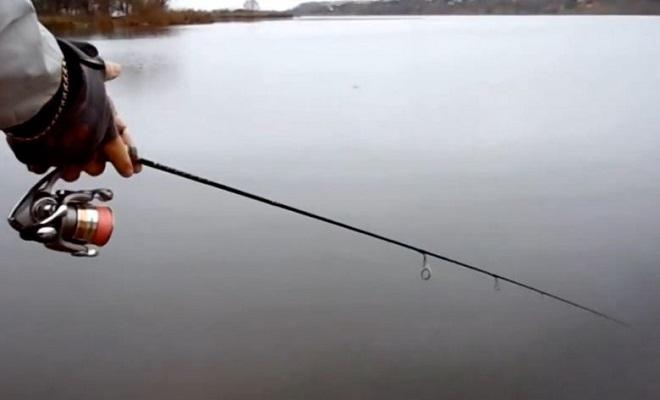
A popular hunting tool for anglers seeking to have predatory fish in their results. Spinning rods are distinguished by a wide range of products with different performance characteristics, directly dependent on the material of the blank and its elasticity capabilities. Good fishing rods of this type allow the fisherman to carry out all kinds of animation of artificial baits at various distances of their presentation, making the game similar to the natural food objects of predatory fish, which is the principle of spinning hunting. In any spinning rod, the lightness of the material and the ergonomics of the handle or butt of the fishing rod are valued. With this method of catching a predator, the tool is constantly at work, in the hands of the spinner, and the comfort of fishing is determined by these important factors.
Types of equipment
This ancient, reliable fishing tool is made from high-tech materials. But the question of how to attach equipment to a fly fishing rod has not been removed from the agenda. In the past, the line was simply screwed to the tip. Convenient means of fastening have now been invented.
Accessories with connector
The fastening element looks like a cap that is placed on the top of the form.
The nozzle is equipped with:
- a cut into which a loop of gear is inserted;
- a slider (lock) that secures the working thread.
A plastic or metal connector is glued to the form. To do this you need:
- Clean the end of the tip with sandpaper.
- Remove dust with a dry cloth.
- Lubricate the cleaned area with superglue.
- Place the cap.
- Wipe off any remaining glue.
Select the connector according to the size of the tip, making sure that the product is free of visible defects, burrs, and sharp edges, otherwise at a critical moment the thread will fray and you will lose the equipment.
An easy-to-install compact item allows you to quickly replace the main line and transport the equipment disassembled. The fastening element in a fishing store costs a penny, but it is not difficult to build it yourself from wire or thick fishing line.
Equipment with elastic band
To dampen persistent jerks of crucian carp, carp, and bream, fishermen use a rubber shock absorber. The length of the elastic (at least 1.5 m, thickness - 1.0-1.8 mm) depends on the expected catch.
You will need:
- elastic band, locking cone (you can take a reel);
- Teflon tip (whip, hollow inside);
- connector
Carry out installation according to the following diagram:
- Trim the end of the last leg of the swing to the diameter of the whip. A hole will open through which the elastic will pass.
- Attach the sleeve to the end of the whip with glue: the elastic will slide along it.
- Insert the tube with an elastic band into your knee (it should go in with force).
- Place a stop cone (reel) inside the 2nd or 3rd section. Attach a shock absorber to it.
- At the other, wide end of the cone (or reel), tie a piece of fishing line to make it easier to get the stopper.
- Assemble the sections.
- Attach the outer end of the elastic band to the connector. To the latter, in turn, attach the working thread.
To make the rubber wear less, apply silicone grease to the inner surface of the form. Elastic can be replaced with latex, but in winter the latter freezes and loses its elasticity.
Equipment and installation of a fly fishing rod is possible using available materials. So, an unexpected use for attaching fishing line to a fishing rod was found in shoelaces. Simply pull their nylon braid over the top, like a stocking, and secure with glue. Attach the fishing line to the other edge using the noose method.
Useful tips
Float fishing is not complete without its little tricks, knowledge of which will not hurt both beginners and experienced fishermen. The success of fishing can depend on many factors:
- The thinner the tackle, the higher the fishing performance. Try to use fishing line as thin as possible. This is especially true for reservoirs actively visited by fishermen. Fish, feeling constant pressure, become much more cautious and demanding of tackle. The same can be said about the float and sinker - small size and high sensitivity.
- Before fishing, don’t be lazy to check your gear. Particular attention should be paid to the presence of damage to the fishing line - while fishing for fish, the fishing line may not hold up and burst, leaving the fisherman without prey and without equipment. You can check the fishing line by holding it between your fingers and stretching the entire working length between them. The presence of cuts, random knots, squeezing are indications for alteration of the gear.
- Keep the hooks sharp. The sharper the hook, the less likely it is to make empty hooks. You can check its sharpness by placing the tip on the nail plate of the thumb and pulling towards the edge of the nail. If the hook is sharp, it will cling to the nail. The dull one will slide off it. You can sharpen it either with a special fine-grained block or with a “grater” on the side of the matchbox.
- Use a landing net. Even a not very large fish can break the leash if the angler makes a mistake. The landing net will make it possible to capture the fish at the most crucial moment of fishing. It is during the pulling of fish ashore that the most offensive slips and breaks of gear most often occur. Breakages of the rod, especially thin tips, are also common at this time. When retrieving, do not move the landing net towards the fish, but lead it towards it, otherwise the fish may get scared and get off the hook.
- Try to make less noise when fishing, especially when fishing close to the shore. The fish is afraid of noise and may move away from the fishing spot. The exception is perch - he loves it. Sometimes fishermen lure it to the fishing spot with splashing or other noise, imitating the sounds of splashing fish. Likewise, the fish can move away from the fishing spot if the fisherman is standing on the shore. If he stands in the water, then he is afraid of it to a much lesser extent.
- Keep an eye on the weather. A falling barometer and a north wind are not the best signs of successful fishing.
- Don't neglect bait and bait. If possible, it is better to feed the future fishing area in advance. The fish, accustomed to receiving food at a certain time, will readily accept bait on the day of fishing. To attach fish, it is best to use natural boiled porridge or cereals flavored with fried sunflower oil. On the day of fishing, it is best to use artificial, strong-smelling bait, which attracts fish with its smell, but does not allow it to get enough.
- The fish bite best at dawn. This must be taken into account when preparing for fishing. Arriving at the reservoir in the midst of the midday heat, it is difficult to count on a good catch.
- A wide variety of bait is used - both plant and animal origin. Bread, semolina and other cereals, dough, potatoes, worms, maggots, bloodworms and many others.
- Don’t get carried away with a large number of fishing rods - this will make it much more difficult to respond to a bite in time. One to three fishing rods will be just right. In addition, different locations may have certain restrictions on the total number of tackle or hooks.
Selection and installation of gear
You can assemble a fly fishing rod yourself on a pond. At home, prepare several reels with different equipment, which you will change depending on the fishing conditions.
What line to put on the fishing rod
For a simple design, spending on expensive braided cords and fluorocarbon will be unjustified, because you will have to cut them into pieces equal to the size of the blank. It is more rational to use single-core monofilament fishing line.
Hard or soft
A rigid, inextensible fishing line will reduce the already limited fishing area. The soft nylon monofilament stretches, adding some catch area. The tensile fishing line can withstand heavy fish weights. For a fly rod, an individual weighing 3 kg is already a trophy specimen. But such a mass of fish is not the limit for the “swing”.
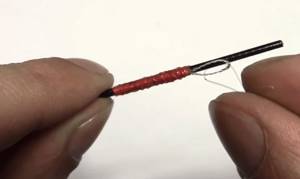
Cambric for fly fishing rod
It is easier to fish the prey to the shore and manipulate the fishing rod with an elastic thread. A soft line marked Soft and a rod dampen the resistance of desperate bottom dwellers. Knots on Soft are knitted easily, without deformation of the thread.
Line thickness
When choosing a fishing line, check it for calibration - the thickness along the entire length should be uniform. It is difficult to determine this visually on a thread less than a millimeter in cross section. Therefore, take a pellet with a through hole. Pass a vein through it: a high-quality one with a uniform structure will slide smoothly, without delay.
For representatives of small and medium-sized underwater fauna, a monofilament thickness of 0.12 mm to 0.2 mm will be sufficient.
Sliding equipment
If you intend to fish at significant depths exceeding the length of the blank, use a sliding version of the fishing rod: allow the float to move freely along the line up and down. To do this, install a rubber stopper above the antenna. Choose the distance from it to the hook depending on the depth at which you are going to fish.
Sliding floats are equipped with one additional built-in ring at the bottom or two - on the body and keel. A strong wind with this installation option does not interfere with casting; the sensitivity of bites increases noticeably.
Standard option
Standard installation is carried out in several steps:
- Lay out the rod.
- Cut a piece of fishing line 20-30 cm smaller than the length of the fishing rod. This is the basis.
- Attach one end to the connector.
- Thread the other through the float.
- Place the weights below.
- Form a loop under them or attach a miniature clasp.
- Tie a leash with a hook.
Prepare several types of rigs at home with fishing lines and hooks of other shapes and types in case the situation on the pond changes. Wind the blanks onto the reel, and you will be fully equipped for the fishing session.
Blind equipment
In the same sequence as in the standard version, assemble the blind equipment. The only caveat: put cambrics on the keel and antenna. And only then pass the line through the float. It must sit tightly on the thread or move with force: spontaneous movement is unacceptable.
In the blind version, place the heaviest pellet closer to the float, then evenly distribute the load along the fishing line, observing the condition: the closer to the hook, the lighter the pieces of lead.
Equipment without rings
This is a traditional, ancient version of mounting a fly tackle - the one that is actually called “simple”. The equipment without rings is an ordinary fishing rod without modern bells and whistles with an equally unsophisticated installation: blank, main line, float, sinkers, hook.
English installation of a fly rod is impossible due to the design on forms with a large number of passage rings on high legs. Inertia-free reels and swivels will also be required. These elements are inherent in Bolognese and match fishing rods: English mounting is used for them.
Selection of shock absorber and connector
The time when shock absorbers for tackle were cut from pharmaceutical rubber bands passed in the 90s. The attribute can now be purchased at a fishing supply store.
The rubber band is needed for long casts, while the “splash” becomes quieter, and retrieving prey becomes easier. The shock absorber saves the tackle from loss, since the fury of the fish’s resistance falls on the elastic rubber part, and breakage of the base has become a rarity.
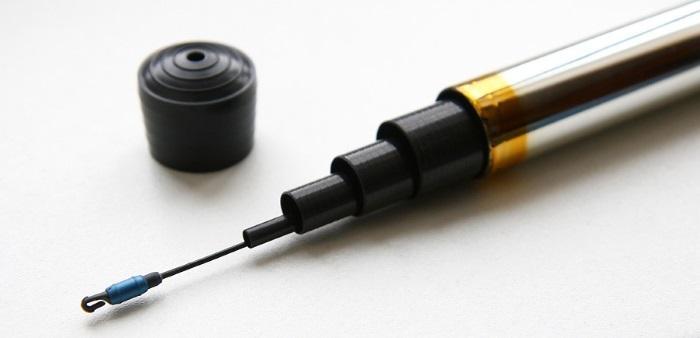
Clutch on a fishing rod
A simple piece of elastic or latex between the rod tip and the working thread does not suit fishermen today. In the latest modifications, shock absorbers come with a safety line and are installed between the sinker and the working thread. Such options are also practiced in fly fishing. The main thing is to choose the diameter of the material. For “swings” 1.2-1.8 mm is enough.
A useful addition is the connector - the connecting link of the form with the fishing line. The miniature thing attached to the tip of the blank does not interfere with the operation of the fishing rod or affect the sensitivity of the equipment. The accessory, usually sold complete with fishing gear, can be purchased separately or made independently, for example, from a paper clip.
Pay attention to the main parameter of the connector – diameter. The item should fit tightly on the form; use superglue for installation. Choose an accessory body without cracks, jagged edges, or sharp edges so that the fishing line does not break on them.
The speed of installation of the connector and the reliability of fastening make such an element indispensable in the “mach” equipment. If handled carefully, this compact item will serve you for more than one session.
Additional equipment for the float rod
Leashes and leash
Leaders are a very useful thing; they allow you to use a larger diameter line and thinner line next to the hook. This increases the strength of the tackle, saves the main line and equipment in case of a snag, and by using thin lines on the leashes it can improve the bite.
To store leashes you need a leash holder, which you can make yourself or find a ready-made one, or you can use the same reels.
We recommend: How to deliciously cook fish over a fire
Share link:
Fishing technique and tactics
Fishing with a fly rod has its admirers and even fans, especially in areas where there are small bodies of water and large fish are rare.
Proponents of swing fishing are right for the following reasons:
- the light weight of the rod allows you to play dynamically for a long time without fatigue;
- the bait is delivered silently;
- at short distances, only the plug is more sensitive;
- the fishing line lasts a long time, as it does not rub against the rings;
- casting is usually accurate, so the fishing pace is fast;
- operation of the tool is easy, the moment of cutting is difficult to miss;
- you can change gear prepared in advance at home in a matter of minutes;
- Fishing is possible from the shore and boat.
A definite plus is the inexpensive equipment of a fly rod and fishing tactics that are not particularly complicated.
How to catch fish
First determine your fishing depth. In summer, the fish does not go to horizons exceeding 4 m. Feed it with aromatic compounds.
Adjust the weights according to the selected depth and keep the base taut. Experiment with tactics: lower the hook to the bottom or keep it suspended. In the second case, the fish are more willing to take the bait. A float that has sunk or gone to the side will definitely indicate a bite. Don't miss the moment, hook when the fish takes the hook completely into its mouth: you will recognize this as it will try to move away.
After hooking, begin leisurely fishing. The main thing is to tire the fish. While fighting, carefully bring her to the shore. Do not make sudden movements, as the line may break or the tip of the rod may break.
Stock up on a landing net with a long handle, substitute it at the right moment, depriving the prey of the chance to get off the hook.
Swing cast
First, select a fixed landmark on the other bank, relative to which you will bring down the tackle. Without knowledge of fly rod techniques, fishing success is unlikely. Neglecting the advice of those who have casting experience leads beginners to mistakes and disappointment.
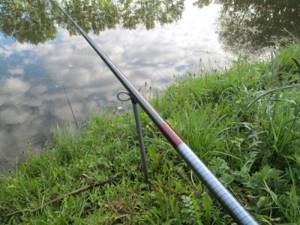
Fly fishing rod
Meanwhile, everything is simple: perform the swing from behind your back (making sure that there is no obstacle behind you). Keep the butt of the rod near your waist; the end plug should be practically motionless.
Slowly throw the rod behind your back. A certain dynamics is needed to ensure that the line is as stretched as possible. Then, with a sharp movement, strictly in one plane, bring the stick towards the water. The further back the tackle is, the more accurately you will send it forward. Since the length of the rod and the main line are unchanged, the hit always occurs at the same point.
If you are working at shallow depths with light attachments, try to keep the angle between the stick and the thread as large as possible.
Features of equipment for catching different types of fish
Experienced fishermen, knowing the character and habits of different representatives of the ichthyofauna, are never left without a catch.
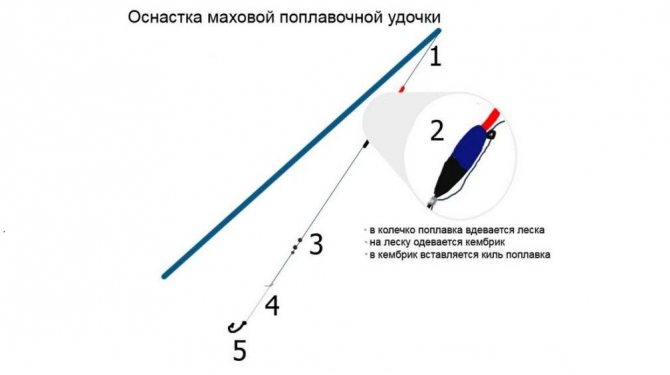
Float rod equipment
A trip to a pond has a specific purpose, but “surprises” can await on a river or lake, for which an experienced hunter is always prepared.
For crucian carp
Crucian carp are often small in size, about the size of a palm. But there are also individuals weighing up to a kilogram. Tench and bleak coexist well with this species. Take this into account when going fishing.
Prepare the rigging of a fly rod for crucian carp with a float carefully.
Rod
Look for crucian carp at the border between coastal vegetation and clear water. Usually it is 5-6 m, take a stick of the same size. Build – average, test – 15-20 g.
The selection criterion is the weight of the form. The heaviest but cheapest fishing rods are made of fiberglass. Composite fishing rods are more expensive. One part of the knees is fiberglass, the other is carbon fiber, so the weight is lower. Carbon products are lighter than the previous two, and the weight decreases depending on the sample of graphite. But expensive forms are very fragile, so do not rush to use them if you are a beginner.
Buy fishing rods that have proven themselves well on Russian reservoirs:
- Salmo Sniper Pole Medium M. Test – 20 g, length – 5 m, composite rod weight – 300 g.
- Salmo Diamonds Travel Pole. The graphite version is the same length - 5 m, test - up to 15 g, weight - 210 g. When folded, the length is 42 cm - convenient for transportation to the fishing spot.
- Salmo Diamonds Pole Medium M. The fishing rod has earned the reputation of being the most catchy for crucian carp: length – 5-6 m, weight – 270 g, test – 20 g.
- Team Salmo Turnament Pole. A carbon fiber rod made of “dry” graphite weighs 150 g with 5 meters of whip. 6 and 7 meter options available. Test – 15 g.
Don't forget that high-tech graphite fishing rods are very fragile.
fishing line
Use monofilament thread with a thickness of 0.17-0.22 mm. For forced fishing of large specimens, a section of up to 0.25 mm will be required. Verified. Choose a soft green line.
With a “swing”, some fishermen go for crucian carp without a leash. But it’s better not to risk the tackle and tie an additional thread two hundredths thinner than the size of the warp.
Float
Choose an elongated form of bite alarm weighing 0.5-2.0 g. Such a float better feels the touch of fish and does not jump on water ripples.
In currents or strong crosswinds, larger floats are needed. On snags and grassy bottoms, bite alarms with one bottom mount work well.
Hooks
Small crucian carp, accordingly, have a small mouth. Match the hooks to the bait. There are universal classic products with an even curve and a middle leg, sizes 10-12.
Crucian carp feeds under the surface of the water and at medium depths, so do not take heavy hooks: they quickly sink to the bottom and can spook the fish. For worm baits, use road models.
Fishing with a float
Fishing with float tackle is possible at any time of the year. The main condition is the absence of ice on the reservoir:
- On a pond, you need to decide on a fishing spot. The best places for this are: a clearing in the reeds or their edge, a “window” in aquatic vegetation, changes in depth, places where streams flow. You should not look for fish on bare ground and far from potential shelter. She most likely isn't there.
- Next, you need to measure the depth at the fishing spot. The easiest way to do this is with your fishing rod. If the original sinker is not capable of sinking the float, then you can add another weight. After this, cast at the intended fishing location, setting the depth at random with the float. If the float remains lying after casting, then it is necessary to reduce the depth. If you drowned, increase it. And so on until the float stands vertically in the water.
- Feed the fishing spot by throwing 3-4 balls of bait the size of a small apple. On your first cast, try to use as wide a variety of bait as possible. This will help to more accurately determine the preferences of the fish.
- Having thrown your gear, expect a bite.
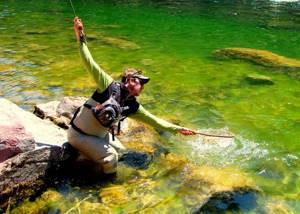
To the roach
Roaches are everywhere in fresh water bodies. You'll find fish in the warm shallows where underwater life gathers and then a school of roach moves in to feed. In spring, look for fish near the shore, where the first young vegetation is emerging - a favorite delicacy for roaches. In autumn, the fish go deeper, and you can only catch them on a sunny day.
The specific equipment of a fly rod for roach is of great importance. Choose a rod of medium action, light, sensitive and durable, 5-7 m long. Although roach in all its varieties (Siberian chebak, roach, ram) is a medium-sized fish, it is also capable of breaking the tackle in the struggle for life.
The roach bites often, the fishing pace is fast, so the small weight of the fishing rod will prevent your hands from getting tired. Use monofilament fishing line with a cross-section of 0.14-0.16 mm. In spring, the camouflage properties of transparent fishing line are important; in summer, green thread will be unnoticeable in the vegetation.
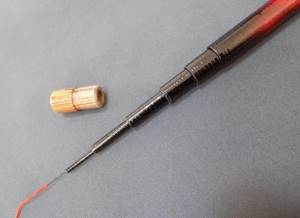
Short fly rod
Leashes 10-12 cm long, thin - 0.12 mm, light hooks - No. 14, 18, less often - 20 (according to the European classification system). The shape of the hooks is not important, the main thing is that they are completely hidden by the nozzle. The color is mostly dark. But sometimes, if the bite dies down, try activating the fish with colored hooks.
Use floats made of foam, plastic or wood. They not only give a signal about a bite, but also keep the hook at the depth you need.
Equipping a fly rod for carp is not complete without a shock-absorbing rubber band with a diameter of 2 mm: a strong fish, resisting, can damage the equipment. Carp line – 0.14 mm, float with a carrying capacity of 0.5-1.5 g, leash – 10-15 cm.
When fishing in the current
Fishing in currents is different from hunting in still water. There are special requirements for the rod blank: it must be light and of medium hardness. A soft stick will bend under the pressure of water, a hard one will not dampen the jerks of the fish, and it will be difficult to fish out the prey.
Flying rod rig for current:
- For shore fishing, take a 5-meter whip, for a watercraft - 8 m.
- The shape of the floats is spherical.
- The leash is long – up to 40 cm.
- On the leash section near the float, place the main weight, then the additional one, and closer to the hook - the sub-weight.
Grazing weight: on a calm watercourse - 0.08-0.15 g, in a stormy river - 0.2-0.5 g.
